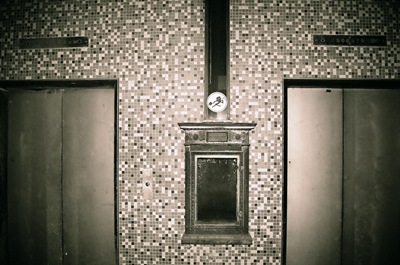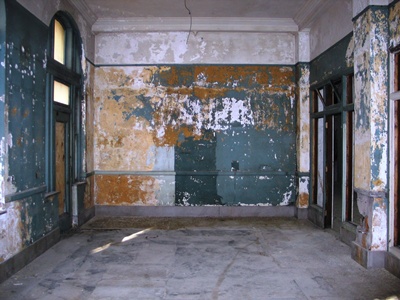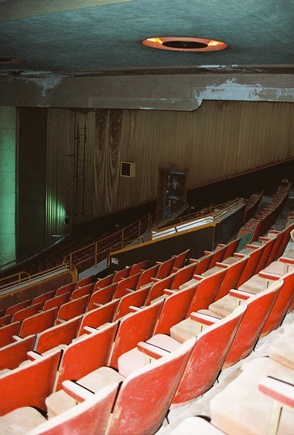 It’s been over eight years since I first wrote about Augusta, Georgia's historic Miller Theater in a post entitled, “Movie Time.” Back then, the Arte Moderne facility, commissioned by Frank J. Miller and designed in 1938 by famed Chicago theater architect Roy Benjamin, had been empty for a couple decades and on the market for years. It appeared accessible, but before we could risk jail time or personal injury we encountered a realtor who saw us taking photos out front and asked if we’d like to have a look inside. Sometimes the easiest way really is the best way, so we took him up on the offer. The theater was huge and ornate, but inside it was cold and dark and hard to get decent photographs. Debris was scattered here and there. Water damage along the walls and ceilings was clearly visible and plaster was crumbling to the floor in places. The realtor said he figured the building could withstand perhaps five more years of vacancy before it would be a total loss.
It’s been over eight years since I first wrote about Augusta, Georgia's historic Miller Theater in a post entitled, “Movie Time.” Back then, the Arte Moderne facility, commissioned by Frank J. Miller and designed in 1938 by famed Chicago theater architect Roy Benjamin, had been empty for a couple decades and on the market for years. It appeared accessible, but before we could risk jail time or personal injury we encountered a realtor who saw us taking photos out front and asked if we’d like to have a look inside. Sometimes the easiest way really is the best way, so we took him up on the offer. The theater was huge and ornate, but inside it was cold and dark and hard to get decent photographs. Debris was scattered here and there. Water damage along the walls and ceilings was clearly visible and plaster was crumbling to the floor in places. The realtor said he figured the building could withstand perhaps five more years of vacancy before it would be a total loss.
That was 2004 and, as of this writing, the Miller Theater is still vacant. However, it has not become a total loss, nor is it still for sale. The building changed hands and was finally purchased by the Miller Theater, LLC, a subsidiary of Symphony Orchestra Augusta. There are big plans for it, including a projected re-opening date during the 2014/2015 season. If you want to read more about the history of the Miller Theater (or about as much as I’ve ever known) you can find my original post HERE.
More recently, I've learned that the building is constructed mostly of concrete and heavy gauge steel reinforcements. Some of the theater’s supporting beams are the largest ever shipped by rail in the state of Georgia. Like I said, the place is big. It was built to hold 1600 seats. Because of this sturdy construction, the structure remains in very good shape. There are still the cosmetic problems I saw in 2004, but apparently nothing that jeopardizes overall integrity or, importantly, would require a massive infusion of cash to fix.
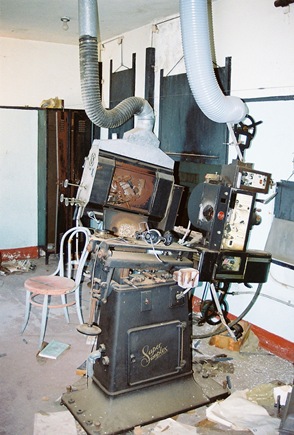 Right now, restoration and renovation is getting underway, but most of the interior of the theater looks pretty much as it did when it shut down thirty years ago. This is especially apparent in the projection booth, where scraps of film litter the floor and the projector itself still sits, perhaps wondering if the day will come when it might return to life. I guess no one has told it that we're in the digital age. Oh well, Katherine Hepburn won’t be coming back for a return visit either. Elsewhere, old signs remain on the doors and ropes hang in the wings.
Right now, restoration and renovation is getting underway, but most of the interior of the theater looks pretty much as it did when it shut down thirty years ago. This is especially apparent in the projection booth, where scraps of film litter the floor and the projector itself still sits, perhaps wondering if the day will come when it might return to life. I guess no one has told it that we're in the digital age. Oh well, Katherine Hepburn won’t be coming back for a return visit either. Elsewhere, old signs remain on the doors and ropes hang in the wings.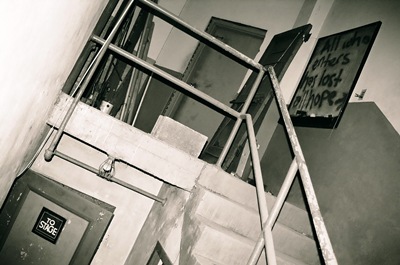
Since the Miller Theater was a movie and vaudeville house when it opened in 1940, the stage is a traditional proscenium style and too small for modern performances. It will be enlarged to twice its original size and
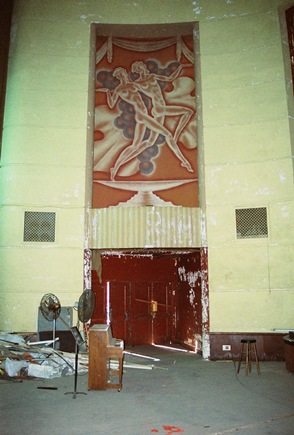 an orchestra pit that can hold 45 musicians will be created. Eventually, a nine foot polished ebony Steinway grand piano will be brought in. Right now, something a bit more modest can be found. When fully outfitted, it’s said the acoustics will be superior to any other venue in the Central Savannah River Area. At 1325, the seat count will be a little less than the original theater, but still a few hundred more than the 800-seat Imperial Theater on the other side of Broad St.
an orchestra pit that can hold 45 musicians will be created. Eventually, a nine foot polished ebony Steinway grand piano will be brought in. Right now, something a bit more modest can be found. When fully outfitted, it’s said the acoustics will be superior to any other venue in the Central Savannah River Area. At 1325, the seat count will be a little less than the original theater, but still a few hundred more than the 800-seat Imperial Theater on the other side of Broad St.
The Imperial Theater? Yes, Augusta does already have an historic fully restored theater just steps away from the Miller. Designed by the famous architect G. Lloyd Preacher in the Victorian Renaissance style and opened as the Wells Theater in 1917, the Imperial is quite nice indeed. Of course, there has been some commentary about the difficulties Augusta might face in trying to support TWO historic theaters, but surely this shouldn’t be a real problem for the second most populous city in Georgia. Frank Miller once operated five theaters in downtown Augusta alone, including both the Miller and Imperial. In any case, the Miller has real potential and to let it become a “total loss,” as nearly happened, seems pretty much unacceptable.

Symphony Orchestra Augusta is excited about the re-opening of the Miller Theater and they should be.
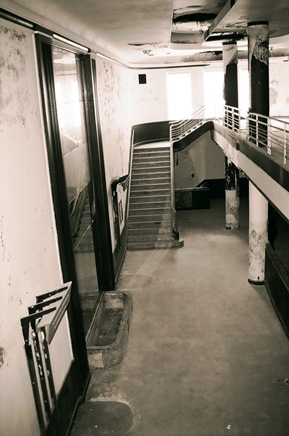 Having also purchased the former Cullum’s building next door, there will be quite a performing arts complex at 7th and Broad St. when everything is finished. The Symphony Board’s stated mission is “to share the joy of great musical performance with our audience.” Those performances can only be enhanced by taking place in a building as soulful as the Miller Theater. “Together, we are music,” is the Board’s tagline. As I recall, Augusta could use some more music, too.
Having also purchased the former Cullum’s building next door, there will be quite a performing arts complex at 7th and Broad St. when everything is finished. The Symphony Board’s stated mission is “to share the joy of great musical performance with our audience.” Those performances can only be enhanced by taking place in a building as soulful as the Miller Theater. “Together, we are music,” is the Board’s tagline. As I recall, Augusta could use some more music, too.This is the last of four posts on historic buildings visited during the 2012 Augusta Photography Festival. Thanks to the festival and the Miller Theater, LLC for providing ample time and somewhat better lighting to explore the place this go-round. Most information was taken from material provided by Symphony Orchestra Augusta. We'll start 2013 with a quick and much more depressing return visit to the historic Goodale Inn, built in 1799. If fast action is taken there may be hope yet for one of the oldest unaltered buildings in Georgia.
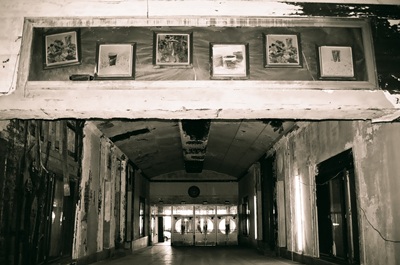
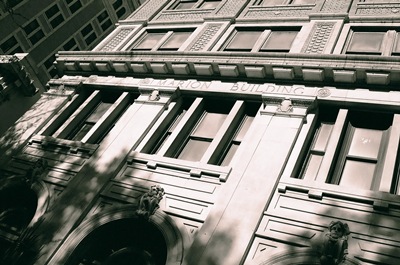
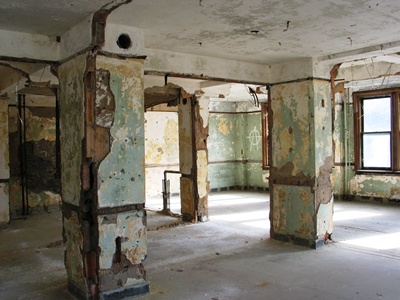
 The two top stories are faced with ornamental polychrome terra cotta in harmonious colors and the entire exterior of the building is trimmed in terra cotta---such as window sills, lintels, etc. All interior floors and partitions are fireproof and the elevator doors, windows on down-town side, etc., are also absolutely fireproof. The first floor lobby is decorated with a high marble wainscoting and plaster cornices. The offices and corridors on the upper floors have smooth finish plaster walls. The corridors all have tile floors and wainscotings of Georgia marble. Ample toilets are provided and they are finished in tile. The trim throughout is genuine oak with veneer doors. The heating system is the best that can be had with a vacuum vapor circulating system. There is enough radiation to overheat the building in zero weather if desired. All floors are provided with vacuum cleaning outlets so that the offices may be perfectly cleaned without dust. Sufficient electric lighting is provided throughout, and every office has a lavatory and an abundance of hot and cold water. There are also two fast elevators, perfectly equipped with indicators, insuring fast service."
The two top stories are faced with ornamental polychrome terra cotta in harmonious colors and the entire exterior of the building is trimmed in terra cotta---such as window sills, lintels, etc. All interior floors and partitions are fireproof and the elevator doors, windows on down-town side, etc., are also absolutely fireproof. The first floor lobby is decorated with a high marble wainscoting and plaster cornices. The offices and corridors on the upper floors have smooth finish plaster walls. The corridors all have tile floors and wainscotings of Georgia marble. Ample toilets are provided and they are finished in tile. The trim throughout is genuine oak with veneer doors. The heating system is the best that can be had with a vacuum vapor circulating system. There is enough radiation to overheat the building in zero weather if desired. All floors are provided with vacuum cleaning outlets so that the offices may be perfectly cleaned without dust. Sufficient electric lighting is provided throughout, and every office has a lavatory and an abundance of hot and cold water. There are also two fast elevators, perfectly equipped with indicators, insuring fast service."